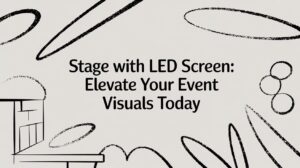
Stage with led screen: Elevate Your Event Visuals Today
Not long ago, a stage with an led screen was just a fancy backdrop. Now, it's the dynamic, beating heart of any modern live event.
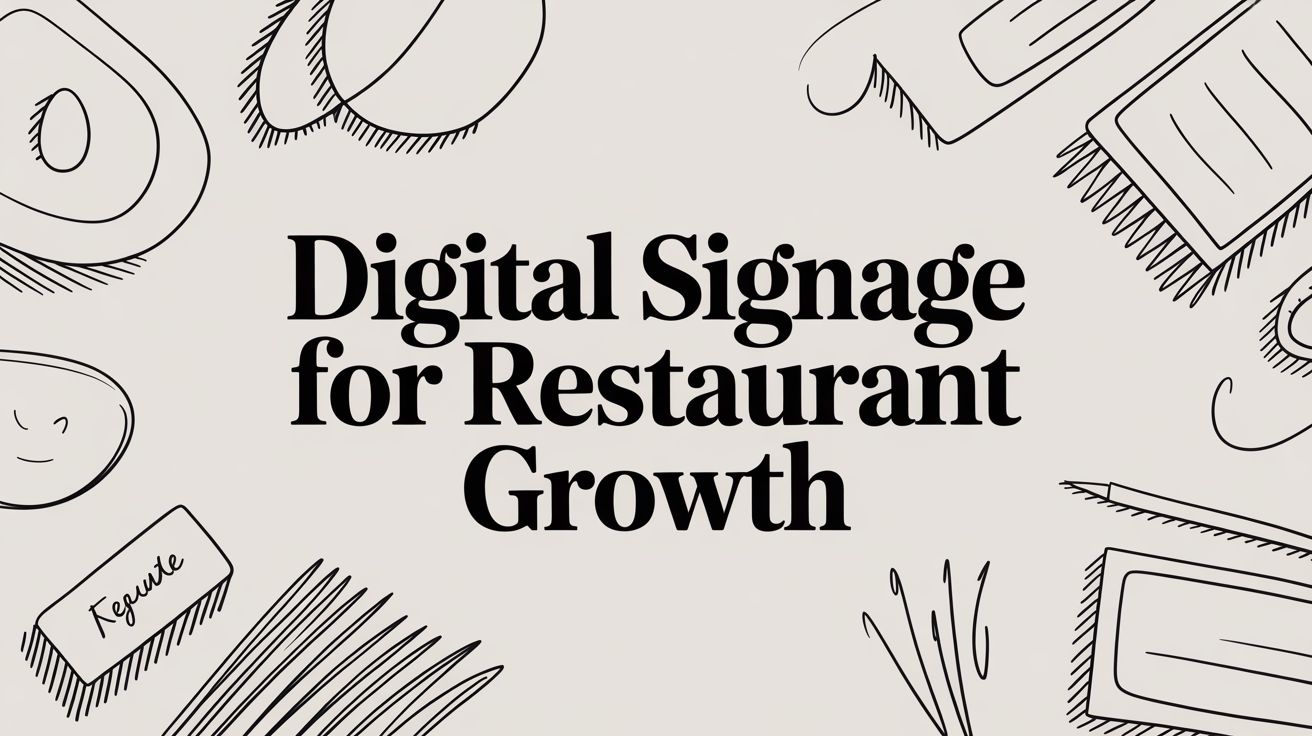
Think of your restaurant’s signs and menus. Are they static, printed pieces of paper? Useful, sure, but they’re silent. They can’t adapt, they can’t persuade, and they definitely can’t show off the sizzle of your signature steak.
Now, imagine those signs coming to life. That’s the core of digital signage. It’s not just about swapping paper for screens; it’s about turning a passive sign into an active salesperson. It’s a strategic tool that lets you instantly update promotions, spotlight your most profitable dishes with mouth-watering videos, and create a vibe that keeps customers coming back.
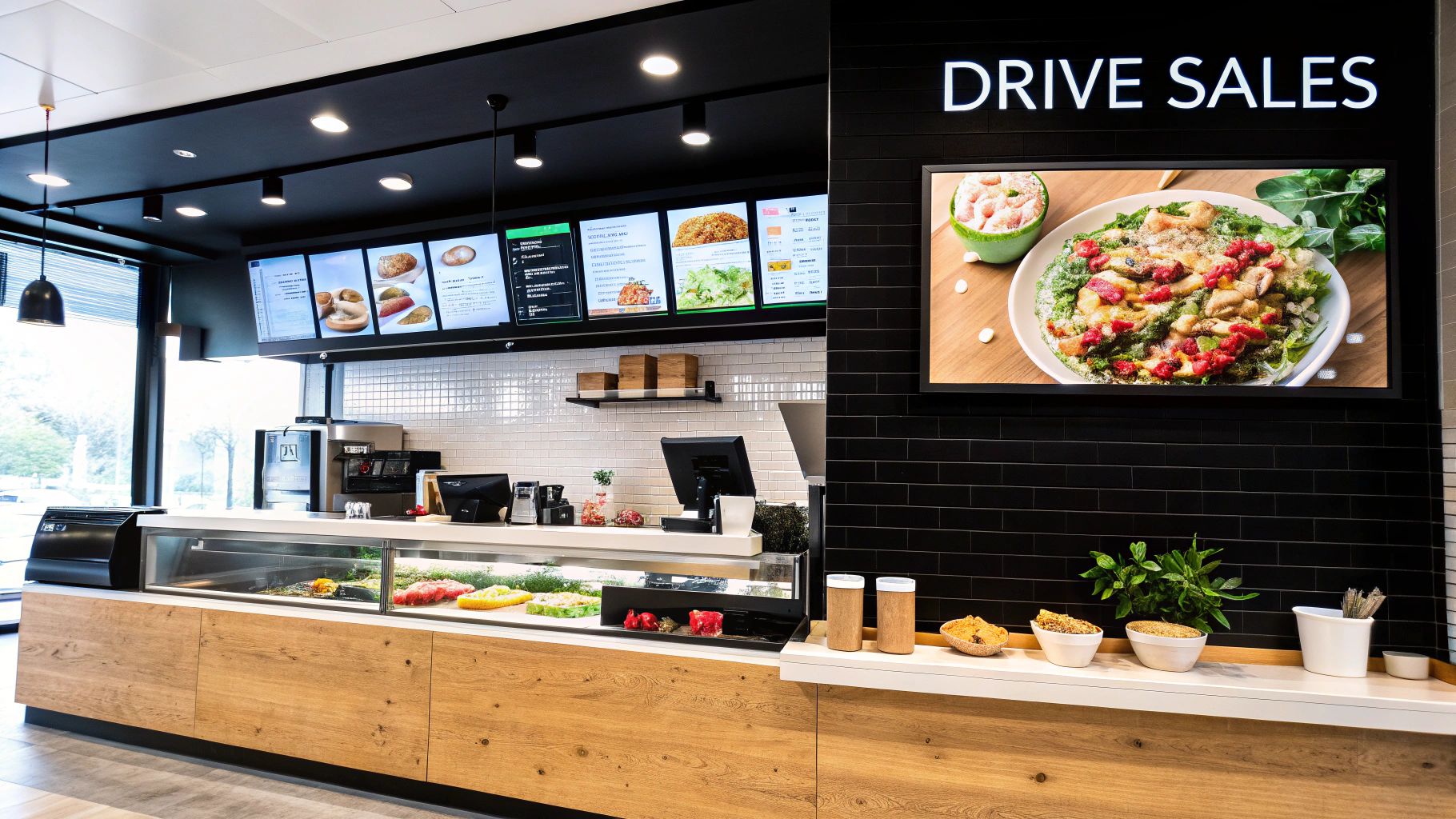
In a market this crowded, just getting a diner's attention is half the battle. Digital screens grab that attention in a way that print simply can't. Your menu board stops being just a list of items and prices and becomes a dynamic, persuasive part of the dining experience itself.
It’s a fundamental shift in how you communicate. This technology can adapt on the fly, interact with your guests, and showcase your food in its best light.
The real magic here isn't just about looking sleek and modern—it's about directly influencing customer behavior while making your own operations run smoother. Digital signage bridges the gap between what’s best in your kitchen and what a customer decides to order, making it a powerful engine for growth.
This is exactly why the market is booming, with the restaurant segment alone projected to hit USD 1.6 billion by 2034. Restaurants are catching on that this isn't a gimmick; it's a smarter way to do business. You can dive deeper into the numbers in the digital signage in restaurants market report.
Digital signage transforms a restaurant's atmosphere from static to dynamic. It’s the difference between handing a customer a flyer and giving them a front-row seat to your culinary story.
When you get down to it, adopting digital screens is about making smarter decisions that echo from the front of the house all the way to the back. Think about these immediate impacts:
By embracing this technology, you’re not just buying screens; you're investing in a more profitable, efficient, and engaging future for your restaurant.
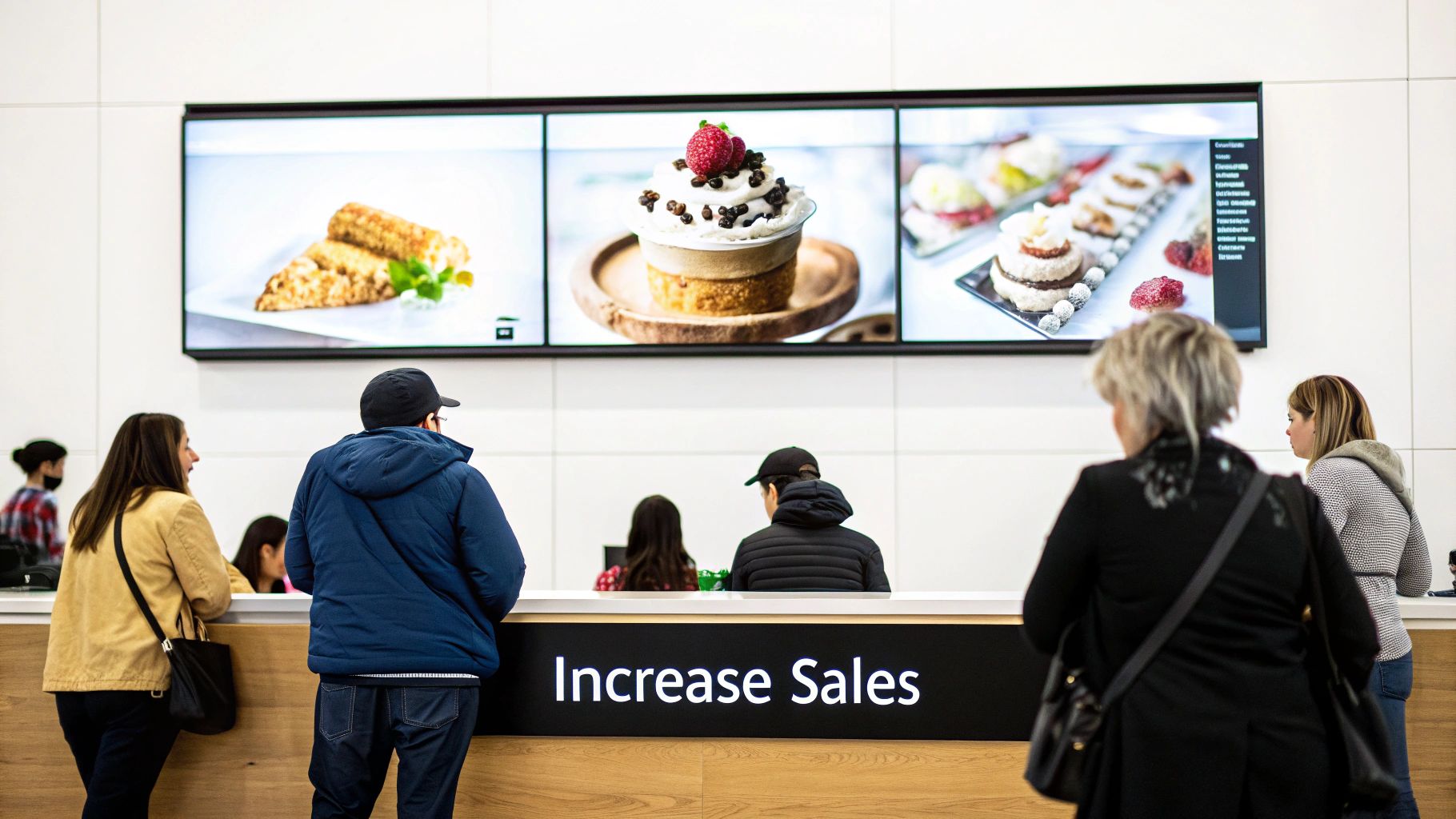
It’s easy to throw around claims that digital signage for restaurants boosts sales, but let’s get into the nitty-gritty of how it really works. This isn't just about slapping up a screen to look modern; it’s a powerful tool that taps into customer psychology and sharpens your operations from the moment someone walks through your door.
Think about your static menu for a second. It's a list of words. Now, imagine a screen showing a slow-motion video of steam curling off your signature pasta, timed to play right as the dinner rush hits. That kind of visual storytelling transforms a menu item into a must-have craving, pushing sales and bumping up your average check size.
The real magic behind the sales boost is control. Digital screens hand you the power to put high-margin items right in the spotlight. Instead of burying your most profitable dishes in a long list, you can give them center stage with vibrant, mouth-watering imagery that a printed menu could never dream of.
And it works. Restaurants that make the switch often see a real jump in sales because the screens are masters at upselling profitable add-ons and highlighting tempting limited-time offers. In fact, studies show this strategy can lead to an average sales lift of 20–30%. It also helps improve order accuracy and even makes wait times feel shorter. If you want to dig deeper into the numbers, you can explore the complete guide on digital signage for restaurants.
Beyond that, you can schedule your screens to change what they show based on the time of day—a slick practice known as dayparting.
This kind of automated scheduling keeps your message fresh and relevant, squeezing every bit of potential out of every minute you’re open.
Let's be honest, nobody enjoys waiting in line. But digital signage can turn that dead time into something engaging. A screen showing fun facts about your ingredients, social media shout-outs from happy customers, or other entertaining clips makes the wait feel like it’s flying by.
By capturing a customer's attention, you're not just distracting them—you're actively improving their perception of your service. A shorter perceived wait time leads to higher customer satisfaction and a greater likelihood of repeat business.
This little psychological trick is one of the most underrated perks. A happy, patient customer is far more likely to order more and walk away with a great impression, turning a potential point of frustration into a chance to build your brand.
When you stack them up side-by-side, the advantages of going digital become crystal clear. It's not just about looks; it's about agility, cost-effectiveness, and creating a better customer experience.
| Feature | Traditional Signage (Printed Menus, Posters) | Digital Signage (Screens, Kiosks) |
|---|---|---|
| Updates & Changes | Manual, costly, and time-consuming. Requires reprinting for every change. | Instantaneous and remote. Update prices or 86 an item in seconds. |
| Visual Appeal | Static images and text. Can look dated or worn over time. | Dynamic, high-definition video, animations, and vibrant images. |
| Customer Engagement | Passive. Customers read it and move on. | Interactive. Can display social media, videos, and promotions. |
| Upfront Cost | Low per unit, but reprinting costs add up significantly. | Higher initial investment for hardware. |
| Long-Term Cost | Ongoing printing, shipping, and labor costs for every update. | Minimal. No recurring printing costs; software fees may apply. |
| Dayparting | Impossible. A breakfast menu is just a breakfast menu. | Simple. Automatically switch from breakfast to lunch to dinner menus. |
| Operational Agility | Slow to react. Can't instantly remove a sold-out item. | Extremely agile. Instantly update menus across all locations. |
Ultimately, while traditional signs have a lower entry cost, digital signage pays for itself through increased sales, operational savings, and an enhanced brand image that keeps customers coming back.
Remember the last time you ran out of a key ingredient for a best-seller? With printed menus, you’re stuck either awkwardly telling customers one by one or scribbling it out with a marker. Digital signage for restaurant operations makes that headache disappear.
With just a few clicks in a cloud-based content management system (CMS), you can instantly pull an out-of-stock item from every screen in your building. The same goes for price adjustments, daily specials, and seasonal menu updates. You’ll save a ton of money on reprinting costs and gain the freedom to pivot your menu in real-time. This also locks in perfect brand consistency across multiple locations, so every customer gets the same polished, up-to-date experience.
When you think of digital signage for a restaurant, the classic menu board is probably the first thing that comes to mind. And while that’s a fantastic starting point, it's really just scratching the surface of what this tech can do for you.
To get the most out of your investment, you need to think of your screens less like posters and more like a versatile toolkit for transforming every corner of your restaurant. The real goal here is to move beyond just displaying static information and start creating a dynamic, responsive environment that guides the customer journey—from pulling them in off the street to influencing that final dessert order.
The customer experience begins long before anyone even places an order. Digital screens, placed strategically at the front of your restaurant, can immediately set the tone, manage expectations, and create an inviting atmosphere from the moment guests walk in.
Think about these high-impact applications:
By engaging customers visually the moment they enter, you're not just decorating your space—you're actively managing their experience, reducing perceived wait times, and building brand loyalty before they even see a menu.
For any restaurant, the digital menu board is a game-changer. It offers dynamic, instantly updateable content that leaves traditional menu printing services in the dust. But even here, there’s so much room for creativity beyond just a simple list of items.
For QSRs, it’s all about speed and clarity. Dynamic menus are a massive advantage, allowing for automated "dayparting" that smoothly transitions your offerings throughout the day.
In a more relaxed setting, screens can add a touch of elegance and help you tell a story.
Digital signage isn’t just for your customers. Screens in the back of house can become the central communication hub for your entire team, boosting efficiency and making sure everyone is on the same page.
By extending digital displays beyond the front counter, you create a connected system that enhances every part of your restaurant, from attracting new diners to empowering your kitchen staff.
Jumping into the world of digital signage for a restaurant means dealing with some new technology, but it’s nowhere near as complicated as it sounds. It really boils down to two main components that have to work together: the hardware you see and the software that tells it what to do.
Think of it like a theater production. Your screens are the stage—the hardware. But you need a director with a script—the software—to put on a show that actually wows your audience. Getting both parts right is the secret to a system that’s powerful, a breeze to manage, and actually makes you money.
Hardware is the physical backbone of your entire digital signage setup. We're talking about the screens your customers will be looking at and the small devices that feed them content. Picking the right gear ensures everything you display looks sharp and your system just works, day in and day out.
One of the first questions I always get is, "Can't I just use a regular TV from a big box store?" While you technically can, commercial-grade screens are built for the grind of a restaurant. They are designed to run for 16+ hours a day, are typically much brighter to stand out in a well-lit dining room, and come with warranties that actually cover business use. A consumer TV will likely burn out faster and using it commercially often voids the warranty.
Here are the key hardware pieces to think about:
The infographic below gives you a quick way to see how different restaurant types might choose their technology.
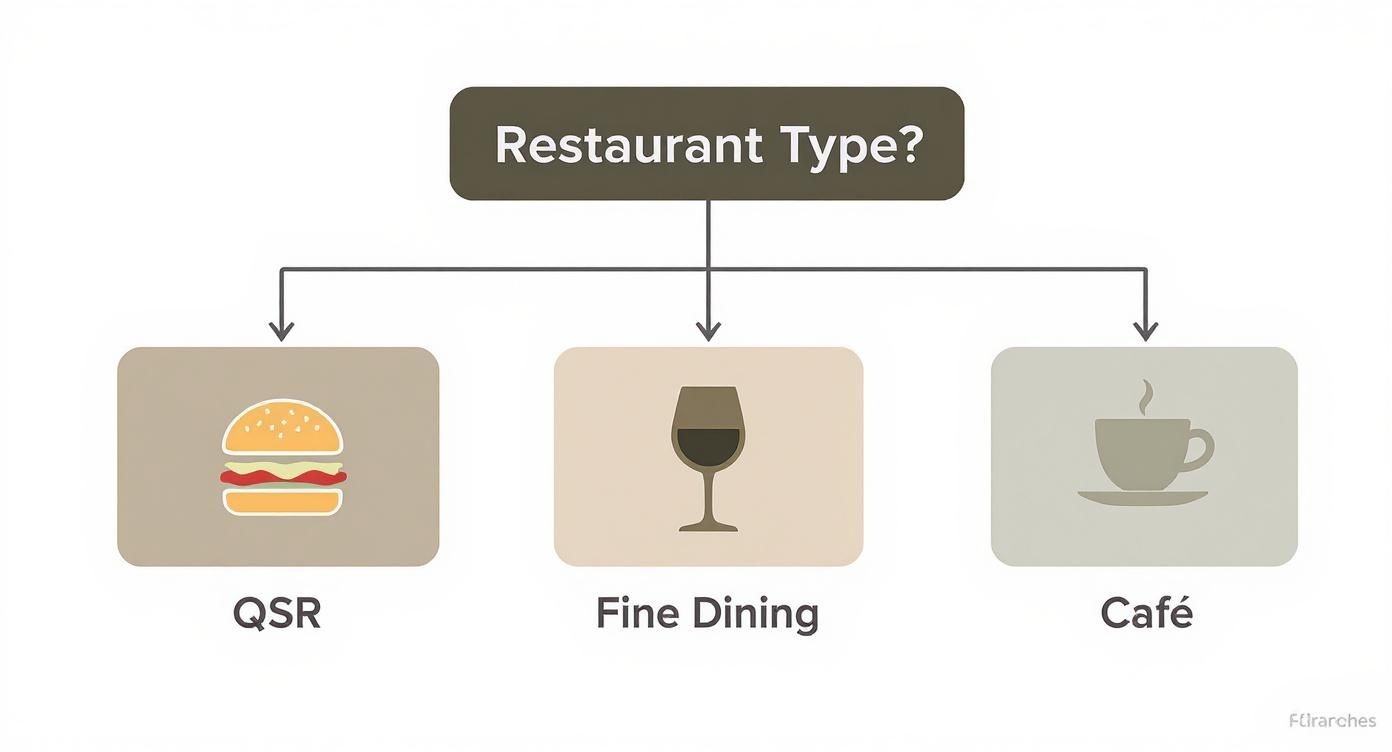
As you can see, a quick-service spot is going to value speed and efficiency above all, while a fine dining restaurant might lean into tech that builds ambiance and tells a story.
If the hardware is the stage, the software is the director—it’s the brains of the operation, bringing your content strategy to life. The single most important piece of software is the Content Management System (CMS). This is your command center, a user-friendly dashboard where you’ll upload photos, design your menus, and schedule what shows up on your screens and when.
A modern, cloud-based CMS is an absolute game-changer for restaurants. It lets you log in from any computer with an internet connection—in the back office, at home, wherever—and push updates to every single screen instantly. That kind of on-the-fly control is what makes digital signage so incredibly effective.
Think of a cloud-based CMS as the universal remote for your entire digital sign network. It gives you the power to change prices, launch a happy hour special, or 86 a sold-out item across all your locations with just a few clicks.
When you're shopping for a CMS, there are a few must-have features that will make your life infinitely easier. For a deeper look at all the different types of display technology out there, you can explore comprehensive guides on LED signs for businesses to get a better sense of what’s possible.
Not all software is created equal, and the last thing you want is a technical headache. To make sure your system is a true business tool, you need a CMS with the right features baked in. As you weigh your options, you may want to explore digital signage technology options from providers like InTouch to see what’s on the market.
Here's a quick checklist of what to look for in a great restaurant CMS.
| Feature Category | Specific Functionality | Why It's Important for Restaurants |
|---|---|---|
| Content Creation | User-friendly templates, drag-and-drop editor, support for video and images. | Lets you create professional-looking menus and promos fast, without having to call a graphic designer for every little change. |
| Scheduling | Dayparting (automatic menu changes), scheduling by day/week, promotional takeovers. | Automatically switches from your breakfast to your lunch menu. You can set it and forget it, running timed promotions without lifting a finger. |
| Remote Management | Cloud-based access, ability to manage multiple screens and locations from one dashboard. | Absolutely critical for keeping branding consistent and making instant updates across all your restaurant locations from anywhere. |
| Integrations | Connection to Point of Sale (POS) systems, social media feeds, and review platforms. | Automates menu updates when an item is 86'd in your POS and lets you show off great reviews and social media posts in real-time. |
| Reliability | Offline playback (content continues to play if internet drops), device health monitoring. | Guarantees your screens never go blank, even if the Wi-Fi gets flaky, and alerts you if there’s a hardware problem. |
By pairing the right hardware for your space with a smart, flexible CMS built for restaurants, you create a digital signage system that doesn't just look good—it actively works to help you grow your business.
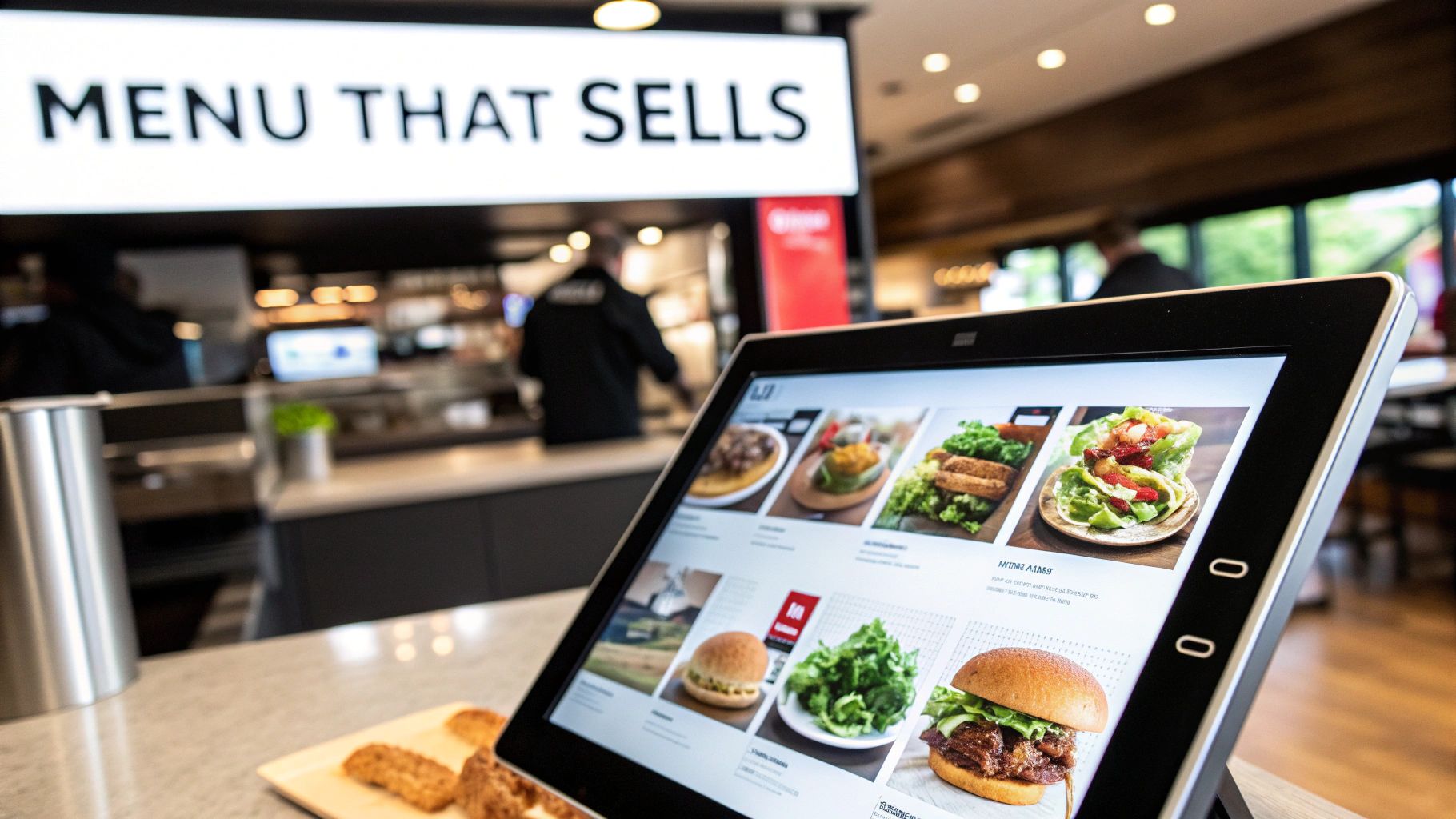
Your slick new digital screens are the stage; your content is the star of the show. A brilliant display with a lackluster message is like a beautiful plate with bland food—it just doesn't work. To really get the most out of your digital signage for restaurant investment, you need a content strategy that’s as thoughtfully crafted as your menu itself.
This means putting on your media strategist hat. Your goal isn't just to list items; it's to create visuals that captivate, persuade, and ultimately drive sales. A well-planned strategy makes sure your displays are always fresh, engaging, and working hard for your bottom line.
The foundation of your whole strategy is a menu that’s a feast for the eyes and dead simple to read. Great design isn't about throwing flashy effects on the screen; it's about clarity and tapping into a little bit of customer psychology. Nail the basics, and your customers will find what they want faster and feel tempted to order more.
Here are a few core principles that always work:
The power of on-screen visuals is no joke. Customer behavior is massively influenced by digital displays, with an incredible 8 out of 10 viewers admitting they've made an unplanned purchase of something featured on a digital menu board. That statistic alone shows just how critical compelling content is for sparking impulse buys and bumping up the average check size. You can find more insights on how digital promotions influence customers on aiscreen.io.
One of the biggest perks of digital signage is the ability to change what's on screen automatically. This is where scheduling, and a technique called dayparting, becomes your secret weapon for staying relevant from sunup to sundown.
Dayparting is simply scheduling different content to play at different times of the day. A cloud-based Content Management System (CMS) makes this incredibly easy to set up.
Think of dayparting like having a different staff member for each shift, each one perfectly trained to sell the right items at the right time. Your breakfast menu automatically appears at 6 AM, your lunch specials take over at 11 AM, and your dinner features go live at 5 PM—all without you lifting a finger.
This automated approach keeps your messaging perfectly aligned with what your customers are craving throughout the day, maximizing the punch of every single promotion.
Putting together a content calendar doesn't have to be some monumental task. The key is to create a rhythm that keeps your displays dynamic and stops them from just becoming background noise.
Here’s a simple, effective weekly content schedule you can adapt for your own spot:
By creating a simple plan, you ensure your digital signage for restaurant is always working to meet specific business goals—whether that's boosting sales on a slow day or encouraging social shares during peak hours. This strategic approach is what turns your screens from passive displays into active, revenue-generating assets.
Alright, let's talk numbers. Bringing digital signage into your restaurant is a serious business decision, not just a fresh coat of paint. To make it work, you need to understand the costs and—more importantly—how you're going to see a return. That’s how you justify the investment and prove it's actually making you money.
It’s a common mistake to think the screen is the only big expense. The reality is, a great digital signage setup is a trio of hardware, software, and the ongoing work of creating content. Looking at all three together is the only way to build a clear financial roadmap.
The upfront cost can swing wildly depending on what you’re planning. A cozy little cafe with one screen has a completely different budget than a QSR chain rolling out displays across multiple locations. But no matter the scale, the core costs are the same for everyone.
And if you're thinking about an outdoor sign to pull people in off the street, that's a whole other ballgame. To get a handle on that specific budget, it's worth digging into guides that break down the outdoor LED sign cost.
Here's where digital signage really shows its muscle. Unlike a static poster you hang on the wall, you can directly measure how your screens are impacting sales and cutting costs. This is how you figure out your Return on Investment (ROI) and prove the system is paying for itself and then some.
Your ROI isn't just about selling more burgers. It's a mix of new revenue, money saved on old ways of doing things, and the long-term value of giving your customers a better experience.
To nail down that number, you have to track the right things. The best way to start is by focusing on a few key areas where digital displays make the biggest and fastest difference.
Sales Lift on Promoted Items: This is a classic. Before you start pushing that new special on your screens, get a baseline of how much you normally sell. Then, run the promotion with some killer visuals for a month and compare the numbers. A big jump is a direct, measurable return.
Increased Average Check Size: Use your screens to consistently tempt customers with high-margin upsells. Think desserts, specialty cocktails, or loaded fries. Track your average check size before and after you put the screens up to see just how much bigger those orders are getting.
Print Cost Savings: This one is the easiest win. Just add up everything you spent last year on printing menus, posters, table tents, and flyers. That entire figure is now a direct saving, and you'll often find it covers a huge chunk of your software subscription right off the bat.
By keeping an eye on these numbers, you stop thinking of digital signage as an expense. It becomes what it truly is: a powerful, data-driven tool for generating revenue. This numbers-first approach gives you the concrete proof you need to validate the investment and make smarter decisions about your content down the road.
Stepping into the world of digital signage for a restaurant is exciting, but it naturally comes with a few questions. Getting the real-world answers is the best way to feel confident about your investment, so let’s walk through some of the most common ones we hear.
Honestly, with a modern cloud-based Content Management System (CMS), updating your menu is ridiculously simple. It’s not a tech-heavy task at all.
You just log in from any computer—even your laptop at home—tweak prices or swap out items using easy-to-use templates, and hit “publish.” Those changes go live on your screens instantly. This kind of flexibility means you can react to an 86’d ingredient or launch a happy hour special in minutes, no graphic designer required.
You could use a regular TV from a big box store, but you really shouldn't. It’s a classic case of using the right tool for the job, and for a restaurant, that tool is a commercial-grade display.
These screens are absolute workhorses, built to run for 16 hours a day or even 24/7 without breaking a sweat. They’re also much brighter, so your menu won’t look washed out in a sunny dining room, and they come with warranties that actually cover being used in a business. They’re designed for the grind of a commercial setting, which means better performance and a much longer life for your investment.
The core difference is reliability. A commercial screen is a workhorse designed for constant use, whereas a consumer TV is a sprinter built for shorter bursts. Choosing the right one prevents premature burnout and ensures your displays always look their best.
Yes, and this is where things get really powerful. Many modern digital signage software platforms are built to talk directly to major Point of Sale (POS) systems.
When they’re linked up, your menu updates become automatic. For example, if you run out of an item and 86 it in your POS, that change can instantly reflect on your digital menu boards. The same goes for price adjustments. This creates perfect consistency between what customers see and what they’re charged, and it saves your team the headache of updating two different systems.
Ready to bring your restaurant’s story to life with stunning visual displays? Smart LED Inc. offers factory-direct pricing on high-impact indoor and outdoor LED solutions built to captivate your customers and grow your business. Explore our digital signage options today.

Not long ago, a stage with an led screen was just a fancy backdrop. Now, it's the dynamic, beating heart of any modern live event.

Forget massive stadium jumbotrons for a moment. When we talk about a small LED display, we’re not necessarily talking about its physical dimensions. Instead, we’re

LED screens on stage aren't just backdrops anymore—they're the pulsing, dynamic heart of today's live events. These huge digital canvases are designed to be insanely
"*" indicates required fields